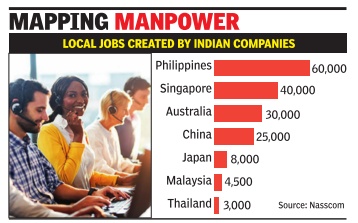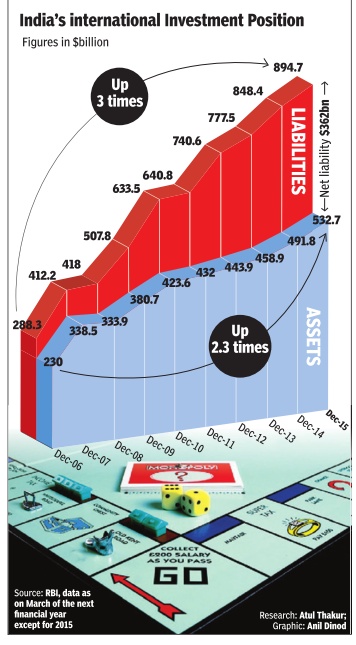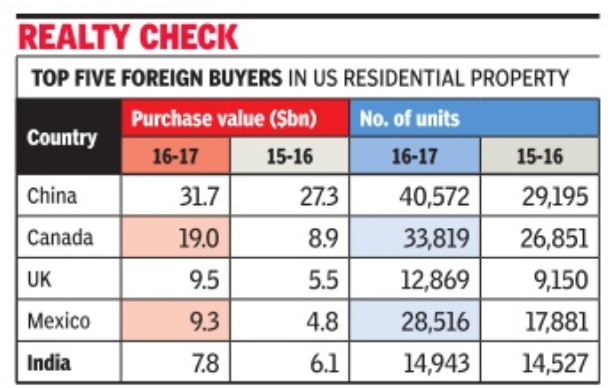Indian investments abroad
This is a collection of articles archived for the excellence of their content. |
Contents |
Employment, local, created by Indian firms abroad
1.71 lakh local jobs in Asia-Pacific (Apac)

Amid tightening visa rules across the globe, the government has told countries in the Asia-Pacific (Apac) region that Indian companies have created at least 1.71 lakh local jobs in nine countries with very few Indians requiring work permits. The issue was flagged with countries negotiating the Regional Comprehensive Economic Partnership (RCEP) agreement, including China, Japan, South Korea, Australia, New Zealand and Asean nations, sources told.
While negotiators from these countries are seeking steep reduction in import duties in India, they are unwilling to allow Indian professionals, such as software engineers and architects, on work visas or even commit to easier investment rules for Indian companies. The Indian govern ment is seeking to impress upon these countries, by making a point that not only do Indian professionals contribute to their economies but companies such as Infosys, Wipro, TCS and HCL also create thousands of jobs.
In recent years, visa restrictions have gone up and the go vernment is accusing the Singapore government of going back on its commitment to allow Indian professionals, despi te committing to it in the bilateral trade and investment treaty .Recently , Australia tightened its visa rules in a bid to check foreigners on work visas, prompting PM Narendra Modi to raise the issue with his counterpart Malcolm Turnbull.
Sources said during a recent interaction that the government had with representatives of companies operating in the Philippines, it came out that Indian IT firms had created close to 60,000 local jobs but needed only 1,500-2,000 work permits.
The companies also said despite Philippine Economic Zone Authority allowing 5% foreign nationals to work if exports accounted for 70% of the business of a company , visas were tough to come by for Indians. As a result, companies were forced to wait for15 days to get business visas, often delaying work.
India is demanding opening up of computer services during the negotiations so that it is not just easier but there is also a stable regime for Indian professionals. Similarly , the government has demanded easier rules in the audio-visual space, which will help Indian film producers, but the RCEP negotiators are reluctant to agree to it.Further, the proposal to have a travel card for Indian business travellers, allowing for seamless movement, is being blocked although the facility is available to Apec members.
Worldwide investments
2000-2016: land purchases

The Times of India
See graphic, ' Land purchased by India, China and other top buyers, 2000-2016 '
2006- 2015: investments

See graphic, ' India's international investment position, December 2006-December 2015 '
2010-11: Investments abroad
From the archives of The Times of India
India Inc’s overseas retail biz on high
In 2010-11, Investment abroad was $1,870m, up 78% from 2009-10
While the Congress government may be finding it difficult to get its FDI in multi-brand retail pass the test of Parliament, India Inc has been pledging huge investments in wholesale and retail trade abroad, including in countries like the United States and Britain. In the 2010-11 fiscal year, investments of Indian companies in wholesale and retail trade overseas went up 78%, as compared to the previous year — up from $1,052 million in 2009-10 to $1,870 million in 2010-11. The trend continues with investments in retail trade made so far by Indian firms overseas accounting for $623 million in the first eight months of the current fiscal year (till November). The other sectors that have been attracting attention of desi companies include manufacturing, financial, insurance, real estate and agriculture, forestry and fishing. In agriculture too, where India has opened FDI doors “under controlled conditions”, Indian companies have made significant investments abroad. From$940 million in 2009-10, the overseas investment portfolio of domestic firms reached $1,200 million in the fiscal year, ending March 31, 2011. With the current logjam in Parliament over FDI, it seems the flight of capital would continue for some time before Indian companies find lucrative returns here. On the issue of FDI in multi-brand retail, the opposition has called it a complete sellout to foreign multinationals. The Left and the NDA are claiming that it would lead to job losses and adversely affect the small traders. Industry chambers have, however, supported the government’s decision and have called it a long-awaited reform that would help small and medium enterprises improve supply chains. An industry estimate puts increase in income in the sector to upwards of $30 billion annually over the next decade. Foreign investments in areas like logistics and repackaging alone is likely to add millions of jobs, according to estimates. With big opposition-ruled states against the FDI, it is expected that even if the Centre succeeds in rolling out the reform, nearly half of the 53 cities that qualify for setting up of multinational chains will miss out on opening their stores. Out of 46 cities, which have a population of 10 lakh and above, 25 can qualify for allowing multi-brand retail majors like Wal-Mart to open stores, but political leadership in these cities have announced their opposition.
2014
Jan 30 2015
In 2014, the outward FDI movement from India was about $2.5 billion. The biggest foreign investments in the year were done by petroleum, real estate, telecom and pharmaceutical companies. The largest chunk of this investment went to Netherlands, Singapore, Jersey and Mauritius, each receiving over $100 million of investments from India accounting for about 80% of the FDI outflow from the country. Indian companies invested in 62 countries last year. Of these, investments exceeded $10 million in only 16 countries. In 26 countries, the investments were less than a million dollars.
2021 Jun vs 2020
July 19, 2021: The Times of India
The overseas direct investment of domestic companies more than doubled to $2.8 billion in June this year, according to RBI data. India Inc had invested just under $1.4 billion in overseas ventures in the year-ago month. However, on a month-on-month basis, the investment was lower by over 58% from $6.7 billion in May 2021, according to the RBI data on outward investments by Indian firms.
Of the total investment during last month, $1.2 billion was in the form of issuance of guarantee, another $1.2 billion was given as loan, while the equity investment stood at $427 million.
Among the major investors were Tata Steel with $1 billion in a wholly owned subsidiary in Singapore, Wipro’s $787.5 million in a wholly owned unit in the US, and Tata Power’s $131.3 million in a fully owned unit in Mauritius. Additionally, RIL invested $56 million in an agriculture and mining based wholly owned subsidiary in Singapore, while Interglobe Enterprises invested $51.5 million in a joint venture in the UK. PTI
Indian MFs’ global kitty
Sep 16, 2021: The Times of India
Total investments by Indian mutual funds (MFs) in stocks listed abroad jumped over three and half times during financial year 2021, boosted mainly by the record rally in most of the global equity markets last fiscal. This was partially also helped by some new funds that domestic MFs had launched during the year.
From Rs 5,808 crore as of end-March 2020, total foreign assets of Indian fund houses jumped to Rs 20,865 crore by end-March 2021, data released by the RBI showed.
There are several MF schemes in India that invest in stocks listed abroad and the trend has suddenly picked up in the last couple of years. These include pure equity funds that invest part of their corpus abroad, and also international funds that invest abroad through the fund of funds (FoF) and exchange-traded fund (ETF) structure, thematic funds, country-specific funds, etc.
Geographical diversification, strong market rally in the past few years and appreciation of foreign currencies are among the most compelling reasons for Indian investors to put their money in these funds, industry players said.
According to the RBI, most of the money invested by Indian MF investors abroad is concentrated in two countries — the US, which accounts for 43.3% of the total corpus, while 42.5% is in Luxembourg.
US govt securities
2016: India the 12th largest holder
India 12th largest holder of US govt securities, Feb 20, 2017: The Times of India
India became the 12th largest holder of US government securities at the end of 2016, with exposure worth $118 billion.
With holdings worth $1.09 trillion, Japan remained the largest holder of these securities followed by neighbouring China with exposure to the tune of $1.06 trillion. After Japan and China, Ireland was at the third place with holdings worth $288 billion, followed by Cayman Islands ($264 billion), Brazil ($259 billion) and Switzerland ($229 billion). “Foreign residents decreased their holdings of long-term US securities in December; net sales were $13.9 billion. Net sales by private foreign investors were $32 billion, while net purchases by foreign official institutions were $18.1 billion,“ the Treasury Department said.
2018, July: India no.13
India's exposure was $142.6bn
USA
Indians no.5 investors in US residential property
Lubna Kably|Indians among top US homebuyers|Jul 21 2017 : The Times of India (Delhi)
Fifth-Largest Foreign Investors In Residential Property, Shows Study
The gloom owing to protectionist policies has not kept Indians residing in the US from investing in real estate. By purchasing residential property worth $7.8 billion during the 12-month period ending March 2017, Indians have emerged as the fifth largest foreign investors in real estate in the US.
Backed by mortgage finance, these properties were largely acquired for use as primary residence, or for a child studying in the US.
Chinese nationals were the biggest buyers, purchasing $31.7 billion worth of residential property . They are followed by Canadians, Britons, and Mexicans.
From April 2015 to March 2016, Indians invested $6.1 billion and occupied third place.However, a surge of invest ments from other nationalities led to India slipping to fifth position in 2016-17 (see table).
The bulk of buyers from China, India, and Mexico were working and residing in the US, while most buyers from Canada and the United Kingdom were non-resident buyers, adds the report “2017 -Profile of International Activity in US Residential Real Estate“, released recently by the National Association of Realtors (NAR).
More than a third of the Chinese buyers purchased residential property in California. Compared to other major foreign buyers, Indians were not as concentrated in any state and the location of their jobs largely determined the purchase. While California, New Jersey , Texas, Massachusetts, and Kentucky were top destinations, more than two in five Indian buyers purchased in other state.
In aggregate, foreign buyers purchased $153 billion worth of residential property in the US between April 2016 and March 2017, which is a 49% jump from the figure for the corresponding period between 2015 and 2016 -$102.6 billion. In terms of units, foreign buyers purchased 2.84 lakh residential properties in the US from April 2016 to March 2017, up 32% from the previous period's 2.14 lakh properties.
On an average, foreign buyers paid $536,852 for their properties, 12% more than the average for the previous 12-month period. The average purchase price as regards property purchased by Indians was $522,440. “The political and economic uncertainty both here and abroad did not deter foreigners from exponentially ramping up their purchases of US property over the past year,“ said Lawrence Yun, NAR's chief economist.“...Foreigners increasingly acted on their beliefs that the US is a safe place to live, work and invest,“ added Yun.
While a stronger dollar makes it more expensive to purchase US property , expectations of further weakening of a local currency prompts some foreign buyers to accelerate their purchases.
Referring to the value of the rupee, the report states that it depreciated modestly (by 2%) relative to the dollar over the survey period. However, after demonetisation in November 2016, the rupee reversed course and began to appreciate.
See also
Indian investments abroad

